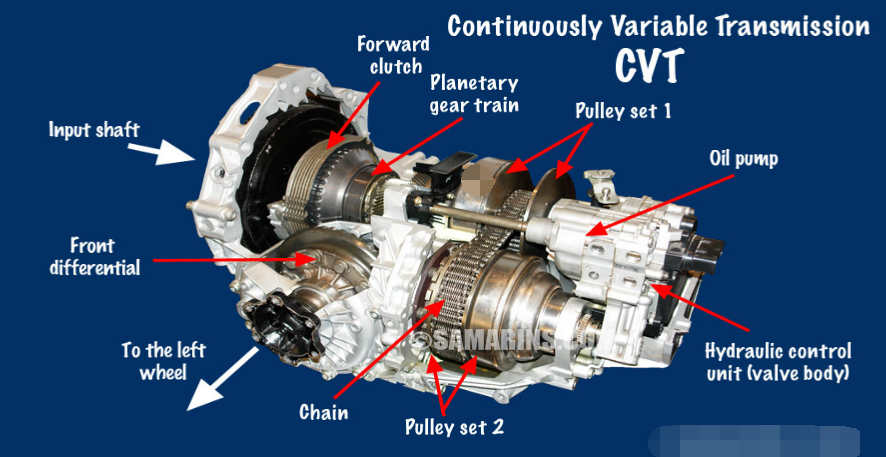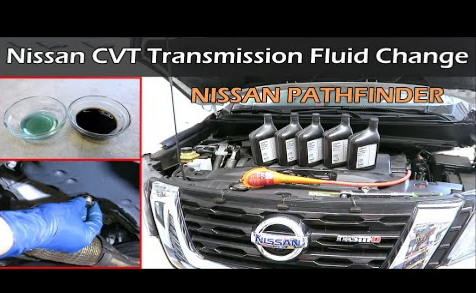Your Nissan CVT might be bad if you notice unusual noises, delayed or erratic acceleration, overheating, slipping between gears, or warning lights on the dashboard.
Common Problems with Nissan CVT
Historical Issues with Nissan CVT
Nissan has faced various issues with its CVT transmission over the years. One of the most common issues includes the transmission overheating, leading to the failure of other parts. This is primarily because the CVT generates more heat than traditional automatic transmissions. The transmission fluid would overheat, leading to the CVT not functioning correctly. The 2003-2010 Nissan Murano was particularly affected by this issue.

Another historical problem is the transmission belt slipping. The belt, which connects the pulleys and adjusts the gear ratio, may slip due to wear and tear, causing the vehicle to jerk or shudder while accelerating. This problem was common in Nissan Sentra, Nissan Altima, and Nissan Rogue models manufactured between 2008 and 2013.
Additionally, there were also issues with the CVT torque converter. A torque converter is used to transmit power from the engine to the transmission. A faulty torque converter can cause poor acceleration, shuddering, and even total transmission failure. The 2007-2012 Nissan Altima and the 2013-2014 Nissan Pathfinder were among the models affected by torque converter problems.
Lastly, another historical issue includes a delayed response when accelerating. The car might take a moment to ‘catch up’ after pressing the gas pedal. This issue was mainly reported by Nissan Murano and Nissan Rogue owners.
Known Recalls or Service Bulletins
Nissan has issued multiple recalls and service bulletins over the years regarding its CVT transmission. One of the major recalls was in 2009, when Nissan recalled over 200,000 vehicles, including the Altima and Sentra, due to an issue that could lead to an increased risk of a crash.
In 2013, Nissan issued a recall for over 300,000 vehicles, including the Nissan Altima, Pathfinder, and Sentra, due to a software problem that could cause the vehicle to stall. This recall included a free CVT software update which aimed to resolve the problem.
Moreover, in 2014, Nissan extended the warranty on their CVTs for certain models manufactured between 2003 and 2010. This extended the powertrain warranty from 5 years/60,000 miles to 10 years/120,000 miles, indicating Nissan’s acknowledgment of the CVT transmission’s problems. This included 19 models like the Maxima, Murano, Sentra, and Versa.
It is always recommended to keep an eye on the recalls and service bulletins issued by Nissan and regularly check if your vehicle is affected.
Please note that the issues mentioned above and recalls may not cover all the problems that may occur with the Nissan CVT transmission. Always consult a professional or the official Nissan service center for the most accurate and up-to-date information. For more detailed information on specific recalls, you can visit the NHTSA website or the official Nissan website.
Please remember that maintaining your vehicle properly and following the manufacturer’s recommendations can help prevent many problems from occurring.

Signs of a Failing CVT
It is essential to recognize the early signs of a failing CVT to prevent more significant problems and potentially expensive repairs. Below are some common symptoms of a failing CVT:
Unusual Noises
One of the earliest signs of a failing CVT is unusual noises coming from the transmission. A well-functioning CVT will operate quietly and smoothly. However, if you start to hear high-pitched whining, rumbling, or rattling noises, it is a sign that there might be a problem with your CVT. This could be due to worn-out bearings or a failing belt or chain. It’s essential to address these noises as soon as possible to avoid more severe problems.
Delayed or Erratic Acceleration
A CVT should provide smooth and continuous acceleration. If you notice a delay when you press the gas pedal or if the vehicle’s acceleration is erratic and the RPMs are jumping around without a corresponding increase in speed, it could be a sign that the CVT is failing. This could be due to a variety of reasons, including a worn-out belt, a problem with the valve body, or a failing torque converter.
Overheating
CVTs tend to generate more heat than traditional automatic transmissions. However, if the CVT is overheating, it can be a sign of a problem. Overheating can cause the transmission fluid to break down, leading to increased wear and tear on the transmission components. If the temperature gauge on your dashboard is reading higher than usual or if you notice a burning smell, it’s crucial to address the issue immediately.
Slipping Between Gears
Although a CVT does not have traditional gears, the term ‘slipping between gears’ is used to describe a situation where the transmission cannot maintain a constant speed or ratio. This can cause the vehicle to feel like it’s jerking or shuddering during acceleration. It could be due to a worn-out belt or chain, a problem with the valve body, or a failing torque converter.

Warning Lights on Dashboard
Modern vehicles have a sophisticated computer system that monitors various components’ performance, including the transmission. If the computer detects a problem with the CVT, it will illuminate a warning light on the dashboard. This could be the ‘Check Engine’ light or a specific transmission warning light. It is crucial to address any warning lights as soon as possible by having a professional diagnose the problem.
Remember, these are just some of the common signs of a failing CVT. Other problems may occur that are not listed here. If you suspect any issue with your CVT, it is always recommended to consult a professional or the official Nissan service center for a proper diagnosis. Regular maintenance and addressing issues early can help prevent more severe problems and extend the life of your CVT. For more information on CVTs, you can visit the CVT Wikipedia page.
Causes of Nissan CVT Failure
Understanding the causes of CVT failure can help in preventing problems before they occur. Below are some common causes of Nissan CVT failure:
Lack of Maintenance
Proper maintenance is crucial for the longevity and performance of any vehicle component, including the CVT. The transmission fluid plays a vital role in the operation of the CVT as it lubricates the moving parts, helps to dissipate heat, and keeps the transmission clean. Not changing the transmission fluid at the recommended intervals can lead to the fluid breaking down and not providing adequate lubrication, leading to increased wear and tear on the transmission components. It is essential to follow the manufacturer’s recommended maintenance schedule and use the appropriate transmission fluid specified by Nissan.
Manufacturing Defects
Although it is less common, manufacturing defects can also lead to CVT failure. In the past, Nissan faced several lawsuits related to CVT failure due to manufacturing defects. For example, a class-action lawsuit was filed against Nissan in 2018, alleging that the CVTs in certain Nissan models were defective and prone to premature failure. Nissan denied any wrongdoing but agreed to settle the lawsuit by extending the warranty on the affected vehicles and reimbursing some owners for the repair costs. For more information on Nissan’s past lawsuits, you can visit this Wikipedia link.
Wear and Tear Over Time
Like any mechanical component, the CVT is subject to wear and tear over time. The belt or chain, pulleys, and other components can wear out after prolonged use, leading to transmission failure. Driving habits can also affect the lifespan of the CVT. For example, aggressive driving, towing heavy loads, or frequently driving in stop-and-go traffic can accelerate wear and tear on the transmission components.
Preventive maintenance and addressing issues early can help extend the lifespan of your CVT and avoid costly repairs. It is always recommended to consult a professional or the official Nissan service center for a proper diagnosis and maintenance of your CVT. Regularly checking for recalls and service bulletins issued by Nissan can also help in identifying and addressing any known issues with the CVT.

How to Prevent CVT Problems
Prevention is always better than cure. Below are some ways to prevent CVT problems:
Regular Maintenance and Service
Regular maintenance and service are crucial for the longevity and performance of your CVT. This includes changing the transmission fluid at the recommended intervals, checking for any leaks, and ensuring that the transmission is adequately lubricated. It is essential to follow the manufacturer’s recommended maintenance schedule and use the appropriate transmission fluid specified by Nissan. Additionally, having your vehicle inspected by a professional or the official Nissan service center can help identify and address any potential issues before they become more severe.
Recognizing and Addressing Issues Early
Being aware of the common signs of CVT failure and addressing any issues early can help prevent more significant problems and potentially expensive repairs. If you notice any unusual noises, delayed or erratic acceleration, overheating, slipping between gears, or warning lights on the dashboard, it is essential to address the issue as soon as possible by consulting a professional or the official Nissan service center.
Using Appropriate Transmission Fluid
Using the appropriate transmission fluid is crucial for the proper operation of the CVT. The transmission fluid lubricates the moving parts, helps dissipate heat, and keeps the transmission clean. Nissan specifies the type of transmission fluid to be used in their vehicles, and it is essential to use the recommended fluid to ensure the proper operation of the CVT. Using the wrong type of transmission fluid can lead to increased wear and tear on the transmission components and ultimately lead to transmission failure.
Remember, preventive maintenance and addressing issues early can help extend the lifespan of your CVT and avoid costly repairs. Regularly checking for recalls and service bulletins issued by Nissan can also help identify and address any known issues with the CVT. For more information on CVTs and their operation, you can visit the CVT Wikipedia page.
What to Do If Your CVT is Failing
If you suspect that your CVT is failing, it is crucial to address the issue as soon as possible to avoid more significant problems and potentially expensive repairs. Below are some steps to take if you suspect a problem and when to seek professional help:
Steps to Take If You Suspect a Problem
- Check the Transmission Fluid: The first step is to check the transmission fluid. The transmission fluid plays a vital role in the operation of the CVT as it lubricates the moving parts, helps to dissipate heat, and keeps the transmission clean. If the fluid is low, dirty, or has a burnt smell, it is an indication that there might be a problem with the CVT. It is essential to use the appropriate transmission fluid specified by Nissan.
- Pay Attention to Warning Lights: Modern vehicles have a sophisticated computer system that monitors various components’ performance, including the transmission. If the computer detects a problem with the CVT, it will illuminate a warning light on the dashboard. This could be the ‘Check Engine’ light or a specific transmission warning light. It is crucial to address any warning lights as soon as possible by having a professional diagnose the problem.
- Observe Vehicle Performance: Pay attention to how your vehicle is performing. If you notice any unusual noises, delayed or erratic acceleration, overheating, slipping between gears, or any other unusual behavior, it could be a sign that the CVT is failing.
When to Seek Professional Help
It is always recommended to consult a professional or the official Nissan service center for a proper diagnosis and repair of your CVT. Although there are some minor issues that you can address yourself, such as topping up the transmission fluid, most CVT-related problems require specialized tools and knowledge to diagnose and repair. Additionally, some repairs may be covered under warranty, and it is always best to have a professional handle these repairs to maintain the warranty.
Remember, preventive maintenance and addressing issues early can help extend the lifespan of your CVT and avoid costly repairs. Regularly checking for recalls and service bulletins issued by Nissan can also help identify and address any known issues with the CVT. For more information on CVTs and their operation, you can visit the CVT Wikipedia page.
